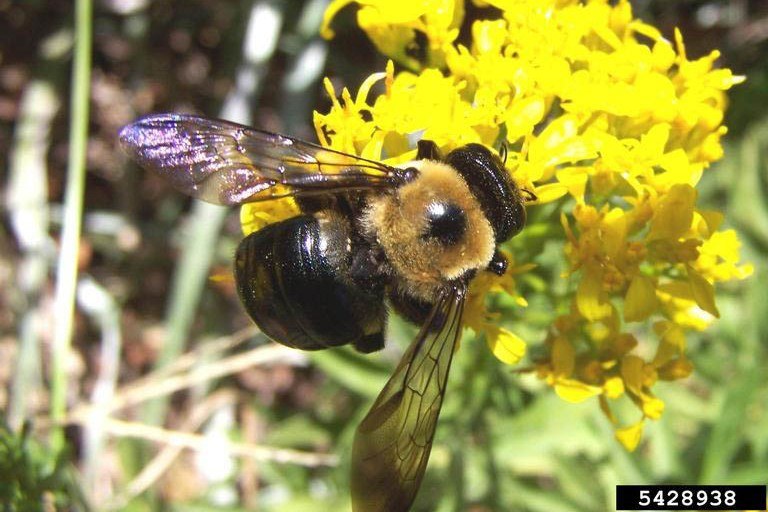People who complain about bumblebees flying about under the eaves of their homes are probably being annoyed by carpenter bees.

Karan A. Rawlins, University of Georgia, Bugwood.org
Bumblebees are large social bees 1/2 to 1 inch long, with black and yellow or, rarely, black and orange body markings. Bumblebee nests are underground and they spend most of their time traveling between the nest and the flowers from which they obtain food.
Carpenter bees, Xylocopa virginica, resemble bumblebees in appearance, but unlike bumblebees, carpenter bees are solitary. Females construct their nests in trees or in frame buildings. Most of the top of the abdomen of carpenter bees is without hairs and is shiny black in color. By contrast, the abdomen of bumblebees is fully clothed with hairs, many of them yellow in color. If you see a number of large bees hovering near the eaves of the house or drilling in wood, you have carpenter bees. There is only one species of the large carpenter bees, Xylocopa virginica, which is encountered in Pennsylvania.
The male bee is unable to sting. It is the male carpenter bee, which is most often noticed. They hover in the vicinity of the nest and will dart after any other flying insect that ventures into their territory. A common behavior of the males is to approach people if they move quickly or wave a hand in the air. The males may even hover a short distance from people causing unnecessary panic. The female however, is capable of stinging but seldom does. She must be extremely provoked (i.e. handled) before she will sting. Carpenter bees do not eat wood. They excavate the tunnels for shelter and as chambers in which to rear their young. They usually attack unpainted objects such as doors, windowsills, roof eaves, shingles, railings, telephone poles, and sometimes wooden lawn furniture.
A carpenter bee begins her nest by drilling a nearly perfectly round entrance hole (about 1/2 inch diameter) into the wood. This hole is usually against the grain of the wood. When the tunnel is about 1 inch deep, the bee turns at right angles to the initial hole and tunnels with the grain of the wood. Bees prefer to attack wood that is greater than two inches thick.
Life Cycle
Young adult male and female bees hibernate in the tunnels during the winter. They mate in the spring and set about to clean out and enlarge the old tunnels or to excavate new ones as brood chambers for their young. Each chamber is provisioned with a portion of "bee bread", a mixture of pollen and regurgitated nectar, which serves as food for the larvae. An egg is deposited on the food supply and each chamber is sealed off. The female typically creates 6 to 8 chambers. The larvae that hatch from the eggs complete their development and pupate. Newly developed adult carpenter bees emerge in August, feed on nectar and return to the tunnels to over-winter.
Adapted from Carpenter Bee Fact Sheet, Steve Jacobs, Sr. Extension Associate
A Few Words from MAEscapes Concerning Carpenter Bees
As homeowners we may at times experience challenges with our wild neighbors. Carpenter bees are native pollinating insects which have adapted to our generous offering of new, attractive, wooden nesting sites. Prior to the disruption of their native forested habitat, carpenter bees were excavating nests in standing tree snags and dead branches for thousands of years.
So before you reach for the insecticide, we first urge you to pause and consider some humane and non-lethal solutions. There may be unintended negative health and environmental consequences with the use of pesticides. Keep in mind that extermination of the bees won't provide a permanent solution because new bees will likely attempt to nest in the exposed wood in the future.
The best way to prevent carpenter bees from damaging wooden structures is to permanently alter the targeted surface. Covering or wrapping the wood with aluminum or vinyl will permanently solve the problem. Painting or varnishing the wood with a thick coating will deter them in most instances. When dealing with structures that are entirely wooden, you may find that bees are attracted only to certain areas, which may lessen the amount of surface area requiring coverage. By taking immediate action as soon as carpenter bees are discovered boring into the wood, you will be able to prevent further damage.
Also consider the wildlife habitat around your home. Dead trees and branches provide natural nesting sites for bees, birds and mammals. If the dead wood is not a safety hazard, consider leaving it in place. It is important to recognize the value of the many beneficial native insects in our environment. When confronted with the detrimental actions of these insects we should practice tolerance before we try to kill them.
For more information about carpenter bees, use this link from the US Forest Service.
Keep in touch! Like us on Facebook

